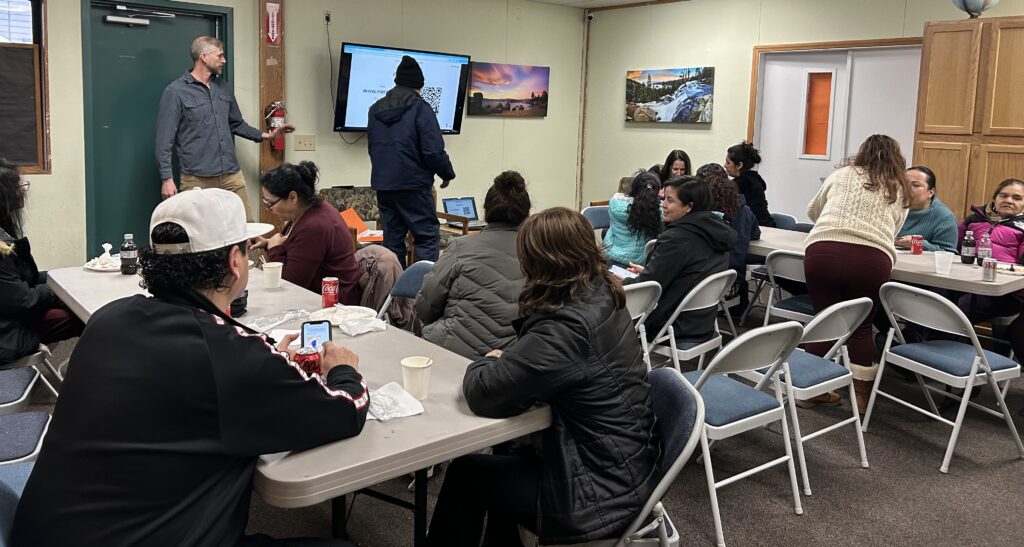
Community Outreach Meeting hosted in Spanish; Photo Credit: Tahoe Prosperity Center
CA FWD’s Voices of Shared Prosperity blog series amplifies the stories of Californians who are committing their time and talent to solutions that embrace equity, environmental sustainability, and economic opportunity.
This year, we’re highlighting leaders who are making a difference in the greater Sacramento region, leading up to the 2024 California Economic Summit taking place in Sacramento on October 8-10.
Lake Tahoe is a California jewel that attracts visitors year-round for its beauty, entertainment and outdoor activities. It is uniquely situated in the Sierra Nevada Mountains encompassing five counties in both California and Nevada, with more than 75 percent of its watershed managed by the United States Forest Service.
“Having the Sierra Nevada Mountains here is really a blessing in disguise in many ways,” said Derrick Martin, program manager at the Tahoe Prosperity Center. He notes that not only does the area’s climate and landscape make it difficult to grow food locally, but much of it is controlled by various governing boards and regulations on federal land. The region has a permanent population of 55,000 with second homeownership as high as 75 percent in some communities and an estimated 15 million visitors annually.
“It presents both barriers and opportunities to collaborate with a lot of our neighbors.” Martin oversees Envision Tahoe, a subregional convener for California Jobs First, the regional investment initiative to grow the state’s economy sustainably and equitably. To achieve the State’s and region’s goals, Envision Tahoe created the Prosperity Playbook, A Share Action Plan for Economic Resilience, Investment and Community Inclusion.
The Action Plan lays out a roadmap to create a region where residents can raise a family in a healthy and sustainable environment, where businesses can prosper and where visitors are welcomed. It includes four long-term goals created with input from community, business leaders and residents:
- Strengthen Key Industries – lead on responsible tourism and attract firms to diversify the economic base,
- Build Skill Pathways for Upward Mobility – create a region-wide skills pathway to align employers, workforce agencies and the educational community,
- Jumpstart the Innovation Ecosystem – build on the growing base of local talent by regularly bringing together entrepreneurs and the support community, and
- Shape the Enabling Environment – create institutional alignment among the various communities and regional governments to work toward widespread agreement on a course of action.
“We are not the ones determining the importance because we’ve really tried to do a good job of gathering community feedback,” said Martin. He cites the Tahoe Inc Initiative as an example of engaging with stakeholders. “That’s a series of entrepreneurship roundtables that the Tahoe Prosperity Center help facilitate in all the counties including those in Nevada as well as Truckee.” He added, “Those small businesses sustain our communities.”
Another important stakeholder group is the region’s residents, “One of the terms we use most often is ‘being able to live where you work.’” But for many who work in the region’s largest sector, tourism and hospitality, the cost of housing is out of reach, forcing workers to commute long distances. Martin added that housing costs are also creating staffing shortages in other areas, “There’s an exclusiveness with being up here in certain facets that’s pricing out essential services like public safety personnel.”
The housing crunch also adds traffic around Lake Tahoe, mostly on two-lane roads. During peak vacation season, those roads are often congested with commuters, sightseeing buses, tourists (who pay more attention to the scenery than the traffic), cyclists and walkers – making for dangerous traffic conditions. “If you don’t have housing and transportation, it means you need to get a car or a rental to be able to participate in the workforce and it increases a lot of environmental concerns.” He added, “I truly believe we should have enough federal support to make a resilient and prosperous transportation system, which includes very much so, alternative methods of transportation.”
Martin joined the Tahoe Prosperity Center after 15 years of working in international business and finance. “That really taught the importance of adaptability and innovation and in Tahoe I tend to try to apply these lessons by using that to foster cross-sector collaboration and leveraging a lot of the global best practices to address the local challenges I saw here.”
And the Tahoe region is familiar territory for him, “I’ve been coming here all through my youth. It has a nice, diverse background that made me feel at home. I’d been living internationally for almost a decade or two before taking this role – the diversity of having the lake, the airport, the people, the different cultures really made it nice for me.”
Looking forward, Martin is working on an entrepreneur ecosystem map or a startup roadmap to streamline the permitting process for rental, sightseeing or other businesses that plan to operate around the Lake. “You have five sets of (county) regulations in two different states, so we want to make sure we are facilitating accurate information and data to support the local community.”
You can learn more about Derrick Martin’s work with the Tahoe Prosperity Center by attending the California Economic Summit on October 8-10 in Sacramento. Registration to attend this year’s Summit it now open.

